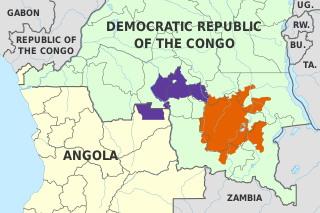This article includes a list of general references, but it lacks sufficient corresponding inline citations. (March 2013) |
| Tshiluba, Ciluba | |
|---|---|
| Native to | Angola, Democratic Republic of the Congo |
| Region | Kasai |
| Ethnicity | Baluba-Kasai (Bena-kasai) |
Native speakers | (6.4 million cited 1991–2018)[1] |
| Dialects |
|
| Official status | |
Official language in | |
| Language codes | |
| ISO 639-2 | lua |
| ISO 639-3 | lua |
| Glottolog | luba1249 |
L.31[2] | |
 Location of speakers:
Luba-Kasai
| |
Preview warning: Page using Template:Infobox language with unknown parameter "native name"
| Pidgin Chiluba | |
|---|---|
| Native to | DR Congo |
Native speakers | None |
Luba-based pidgin | |
| Language codes | |
| ISO 639-3 | None (mis) |
| Glottolog | None |
L.30A[2] | |
Luba-Kasai, also known as Cilubà or Tshilubà,[4] Luba-Lulua,[5][6] is a Bantu language (Zone L) of Central Africa and a national language of the Democratic Republic of the Congo, alongside Lingala, Swahili, and Kikongo ya leta.
An eastern dialect is spoken by the Luba people of the East Kasai Region and a western dialect by the Lulua people of the West Kasai Region. The total number of speakers was estimated at 6.3 million in 1991.
Within the Zone L Bantu languages, Luba-Kasai is one of a group of languages which form the "Luba" group, together with Kaonde (L40), Kete (L20), Kanyok, Luba-Katanga (KiLuba), Sanga, Zela and Bangubangu. The L20, L30 and L60 languages are also grouped as the Luban languages within Zone L Bantu.
- ^ Tshiluba, Ciluba at Ethnologue (27th ed., 2024)

- ^ a b Jouni Filip Maho, 2009. New Updated Guthrie List Online
- ^ "ki te te la" is Standard Orthography, pronounced like "k retell" and "ke Te Te la".
- ^ The prefix tshi or ci, depending on the spelling used, is used for the noun class used with language names
- ^ "Luba-Lulua" combines the name "Luba" (in the strictest sense, Luba Lubilanji people) and "Lulua" (Beena Luluwa people), as in "the Luba-Lulua conflict".
- ^ Ethnologue.com also indicates the name "Beena Lulua" but that is the name of the Beena Luluwa people, or the name "Luva" but that is a synonym of Kiluba (Kiluva), a different Luban language, which has a fricative bilabial between vowels.